[Note: This post was originally written and published in January 2013. A lot of things have changed since then, obviously. Please keep that in mind when you read this.]
Iceland Wants to Be Your Social Media Campaign
Oh, hello.
We're Takk Takk, and we help good people, groups, organizations, companies, and one country make friends and influence people. On this page you'll find a behind-the-scenes look at something we made and we're quite happy with.
![]() It's called Iceland Wants to Be Your Friend, and it's a social media campaign for Iceland. Originally launched at the initiative of the Icelandic Tourist Board, it's now a free-standing project, loved and cared for by many good people, using brains and fancy machines. We hope you like reading about it.
It's called Iceland Wants to Be Your Friend, and it's a social media campaign for Iceland. Originally launched at the initiative of the Icelandic Tourist Board, it's now a free-standing project, loved and cared for by many good people, using brains and fancy machines. We hope you like reading about it.
How do you create a social media campaign for an island in the middle of the ocean?
In late 2009 a nice man called Jón Gunnar Borgþórsson at the Icelandic Tourist Board asked us to come up with some ideas about how to use social media — a highly fashionable concept — to attract attention to Iceland as a tourist destination.
This, by the way, was long before that little volcano erupted.
After looking briefly at what others were doing, we thought about it, and decided to do something completely different. We called it Iceland Wants to Be Your Friend, and it was launched in October 2009 with no fanfare whatsoever.
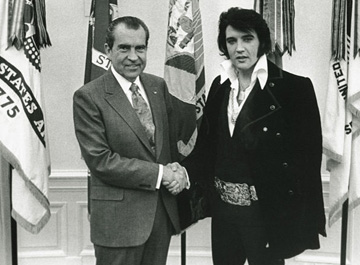
We completely forgot to take a picture at the launch, but as we remember it, the whole thing was very similar to what's going on in this picture.
And now for something completely different
A simple and conventional way to approach this project would probably have been to create a few social media profiles here and there for Visit Iceland, and build a nice looking website with pictures of landscapes and attractive people. This is how most countries go about doing things (and maybe for good reason).
But because Iceland is quite different from most countries we decided to do something quite different.
We would simply put Iceland itself on the Internet.

The big idea behind Iceland Wants to Be Your Friend is that Iceland — a remote island in the middle of the Atlantic, millions of years old, home to many humans, mountains, waterfalls and sheep — has somehow discovered "The Inter-nets" and how to use "them" to talk to people.
As you would expect from a very old island in the middle of the ocean, it talks a bit funny, and doesn't always understand its human friends very well. (And of course it uses Courier.)
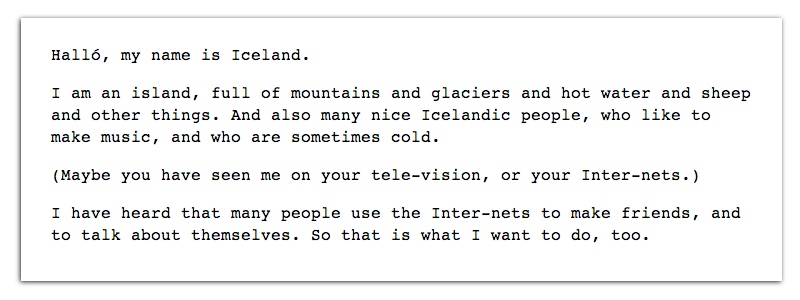
People may not understand how Iceland does this — is there a really big keyboard somewhere in the Westfjörds? — but somehow it manages to have a presence on several places on the Internet. It's on Facebook, Twitter, Tumblr, Vimeo, Flickr, Foursquare, and there's a blog about it.
In its first year, Iceland Wants to Be Your Friend has been described by serious adults who know about these things, "an object lesson in how to do social media well", "a lesson in the aesthetic value of consistency, simplicity and friendliness", "exemplary in terms of the simplicity and finesse of its approach", "intriguing, engaging and remarkable" and "incredibly well done".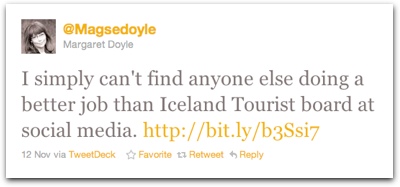 It has been praised for "its consistency over a range of social media channels, and an authentic voice" and called "absolutely hilarious, genius, and refreshing." A nice person in Slovenia has said she hopes her local Tourist Board "can learn something from this", and an actual Italian wrote that Iceland is probably cooler than Italy (if only on the Internet). (They have also said other nice things you can read if you're not terribly busy.)
It has been praised for "its consistency over a range of social media channels, and an authentic voice" and called "absolutely hilarious, genius, and refreshing." A nice person in Slovenia has said she hopes her local Tourist Board "can learn something from this", and an actual Italian wrote that Iceland is probably cooler than Italy (if only on the Internet). (They have also said other nice things you can read if you're not terribly busy.)
It's been featured on lots of blogs, nominated for awards and even won some. It even made it into New York Magazine's infamous approval matrix.
But we're getting ahead of ourselves.
Iceland on the Inter-nets
Iceland Wants to Be Your Friend.com
Iceland Wants to Be Your Friend is designed to be open-ended and adaptable mutatis mutandis to almost any social media platform over an indefinite period of time. It does not have a central site that everything else radiates from. It simply exists on whatever platforms humans decide to use.
However, one could say that its home is Iceland Wants to Be Your Friend.com
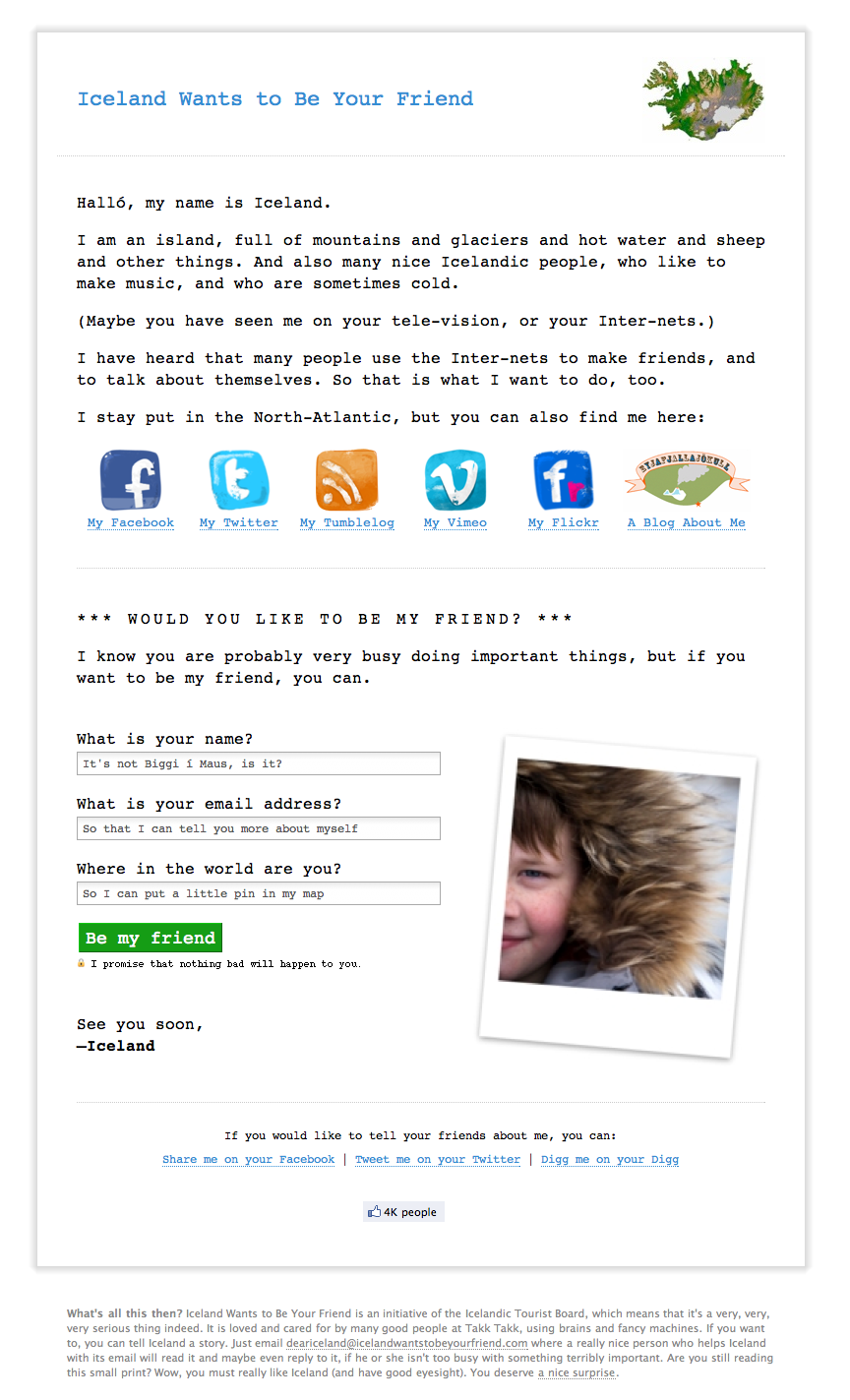
This site does several things. First of all it serves as an introduction to the project as a whole in terms of the design (a very minimal, undesigned look and feel) and a certain quirky, clunky style of writing ("Halló, my name is Iceland"). It looks very simple and easy to take in — no wham-bam flashy stuff — but in a way that hopefully mirrors the rest of the project, it rewards visitors who give it extra attention. An example of this is waiting for the people who have the patience to read through all the small print …

… and those brave souls who peek at the source code …

Secondly, it's where visitors can "become Iceland's friends" by subscribing to its newsletter (nothing bad will happen, Iceland insists).  The subscription process involves a thank-you page and a nice thank-you email designed to draw visitors deeper into the project with links to its various social media sites. (More about the newsletter itself here below.)
The subscription process involves a thank-you page and a nice thank-you email designed to draw visitors deeper into the project with links to its various social media sites. (More about the newsletter itself here below.)
Finally, Iceland Wants to Be Your Friend.com is where all the different social media components of the project are gathered in one place for visitors to browse through in case they don't sign up to be Iceland's friends. (After all, not everyone is ready for a such big commitment to an island.)

It's worth repeating that even though this site is the project's "home" it's not necessarily an objective in itself to direct traffic to it. It's perfectly possible to come into contact with the project without ever visiting Iceland Wants to Be Your Friend.com. A person can become a fan of Iceland on Facebook, a follower on Twitter, or see one of its videos embedded on the blog of a Paris sewing café without ever coming across Iceland Wants to Be Your Friend.com, reading its blog on Tumblr, or finding it on Foursquare. And that's absolutely fine.
And speaking of Facebook …
Iceland on Facebook
One of the very first things Iceland did was get itself a profile on Facebook (or "The Face-Book", as Iceland calls it).
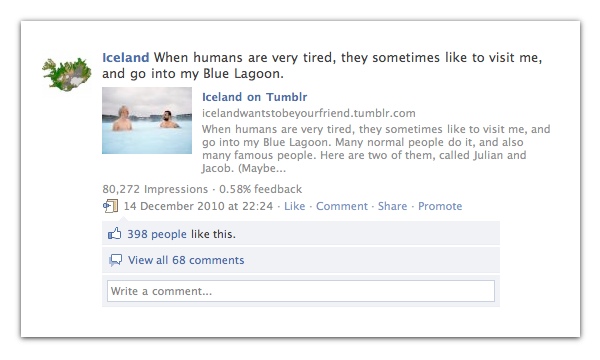
To no-one's great surprise, Facebook has turned out to be a crucial for the project. With around fifty-eight thousand fans, Iceland posts status updates sparingly (on purpose, about two to four times a week) but consistently has what we believe are very high impression and feedback rates.
While Iceland's own status updates are a very important part of its activity, it actually puts much more work into monitoring and dutifully replying to the roughly 40 to 70 items a week that its fans post on its wall every week.
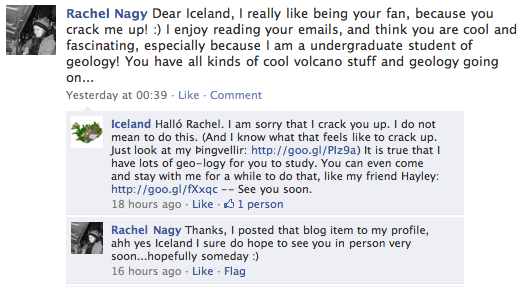
A great deal of care goes into crafting each reply from Iceland, and tailoring it each individual post, while hopefully maintaining the same overall stylistic voice.
This element of the project — its nature as an endless series of one-on-one interactions — is very much on view on Facebook, and is what we think really sets it apart from campaigns that may well be conducted in social media but are nevertheless rooted in a more traditional broadcasting model. It also makes the project harder to take in from the "outside", as it were.
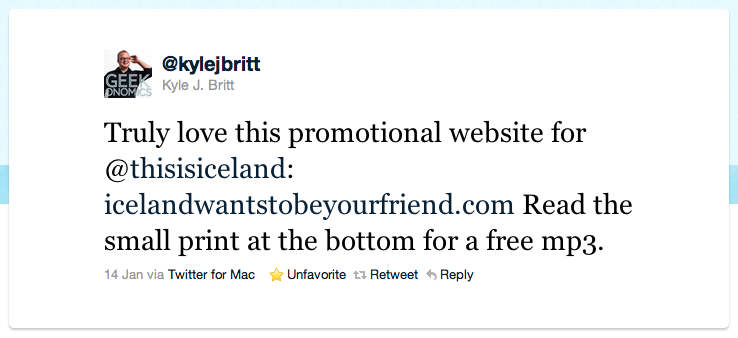 Whereas the quality of a more traditional campaign can be quickly and easily judged based on viewing a few print ads, TV commercials or slogans, Iceland Wants to Be Your Friend is to a large extent designed to be experienced as a series of individually tailored personal interactions.
Whereas the quality of a more traditional campaign can be quickly and easily judged based on viewing a few print ads, TV commercials or slogans, Iceland Wants to Be Your Friend is to a large extent designed to be experienced as a series of individually tailored personal interactions.
It also relies on the element of surprise and hopefully even a little joy for users whose curiosity is piqued enough for them to start digging around in what seems to be a very simple concept, only to find that it's full of nice surprises. 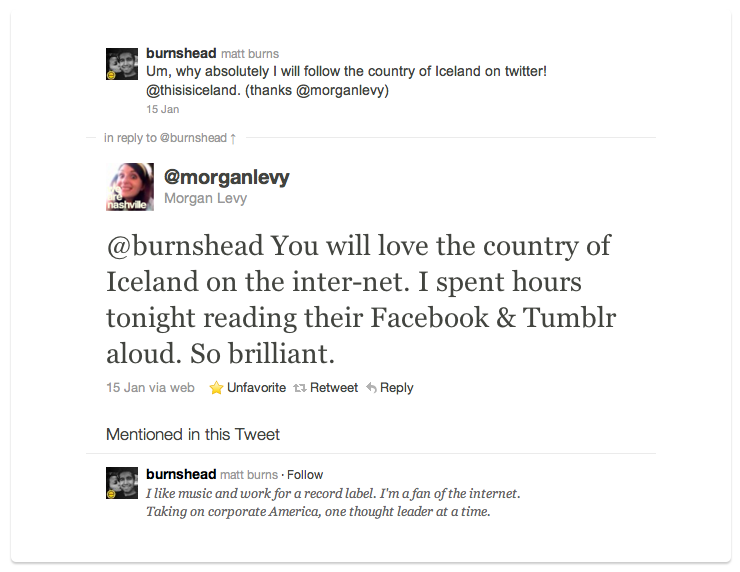 To work, it demands a tiny bit more attention than absolutely necessary, and in that way tries to show respect for the intelligence of the people with whom it's interacting. (This approach is ingrained in the DNA of the whole project, and we'll talk about in greater detail here below.)
To work, it demands a tiny bit more attention than absolutely necessary, and in that way tries to show respect for the intelligence of the people with whom it's interacting. (This approach is ingrained in the DNA of the whole project, and we'll talk about in greater detail here below.)
Facebook has proved an immensely valuable tool for the project, both as a venue where it takes place, as a way for users to share it with each other, and, by means of Facebook's targeted advertising options, very effective in finding the people potentially interested in Iceland (more people come across the project on Facebook than on any other channel).
Iceland on Twitter
After Facebook, the next step for Iceland was to set itself up on Twitter where it started tweeting as @thisisiceland.
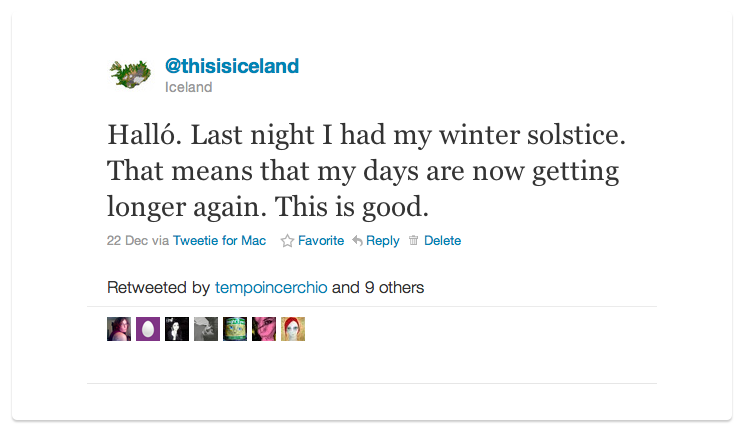
Iceland has by now tweeted over 2,100 times and has about 4,300 followers (all organic). It has healthy retweet and @mention rates, and according to goo.gl, links in non-reply tweets are usually clicked by about fifty to a few hundred people.
Iceland uses Twitter in several ways. First of all, much like the humans who follow it, it just tweets about itself.
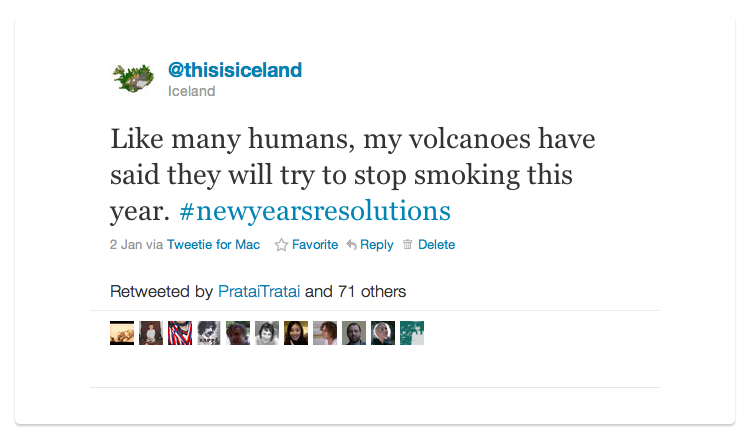
It also @replies to people who @mention it like here in this answer to Evenlyn Hannon's question about temperature (always an interesting topic).
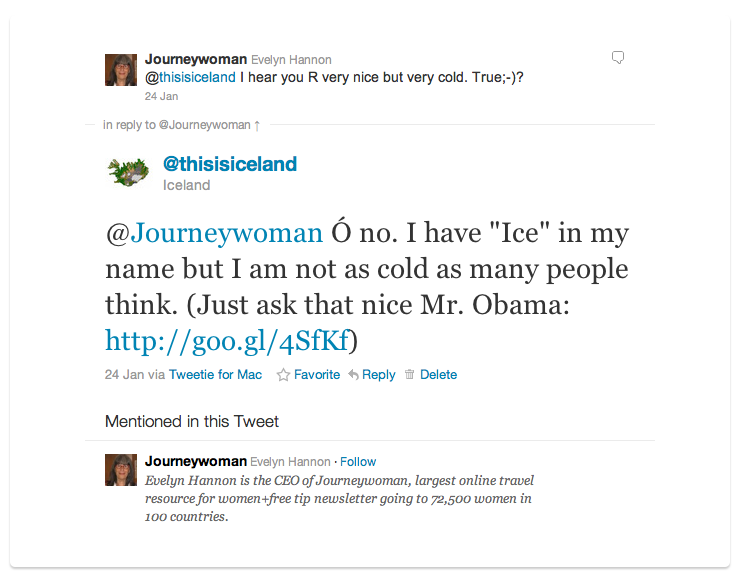
A simple way of getting lots and lots of random followers would have been to regularly have competitions where followers can win things (trip to Iceland, anyone?), for example by retweeting something. For reasons we'll go into later, Iceland has completely avoided this, both on Twitter …
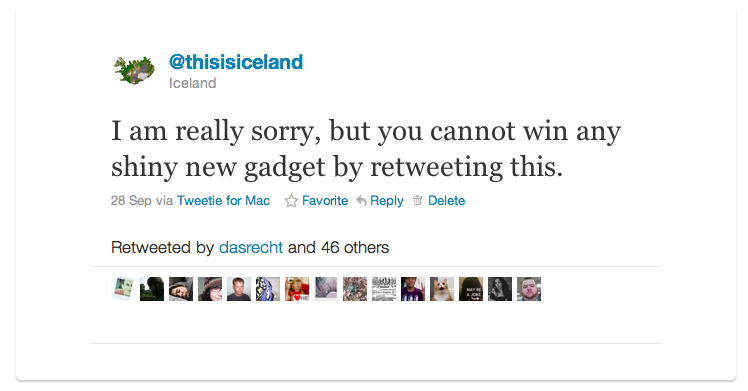
…and on Facebook …

A Blog About Iceland
Soon the project grew a blog, imaginatively titled "A Blog About Iceland", featuring posts either written by or about people who live in or have visited Iceland.
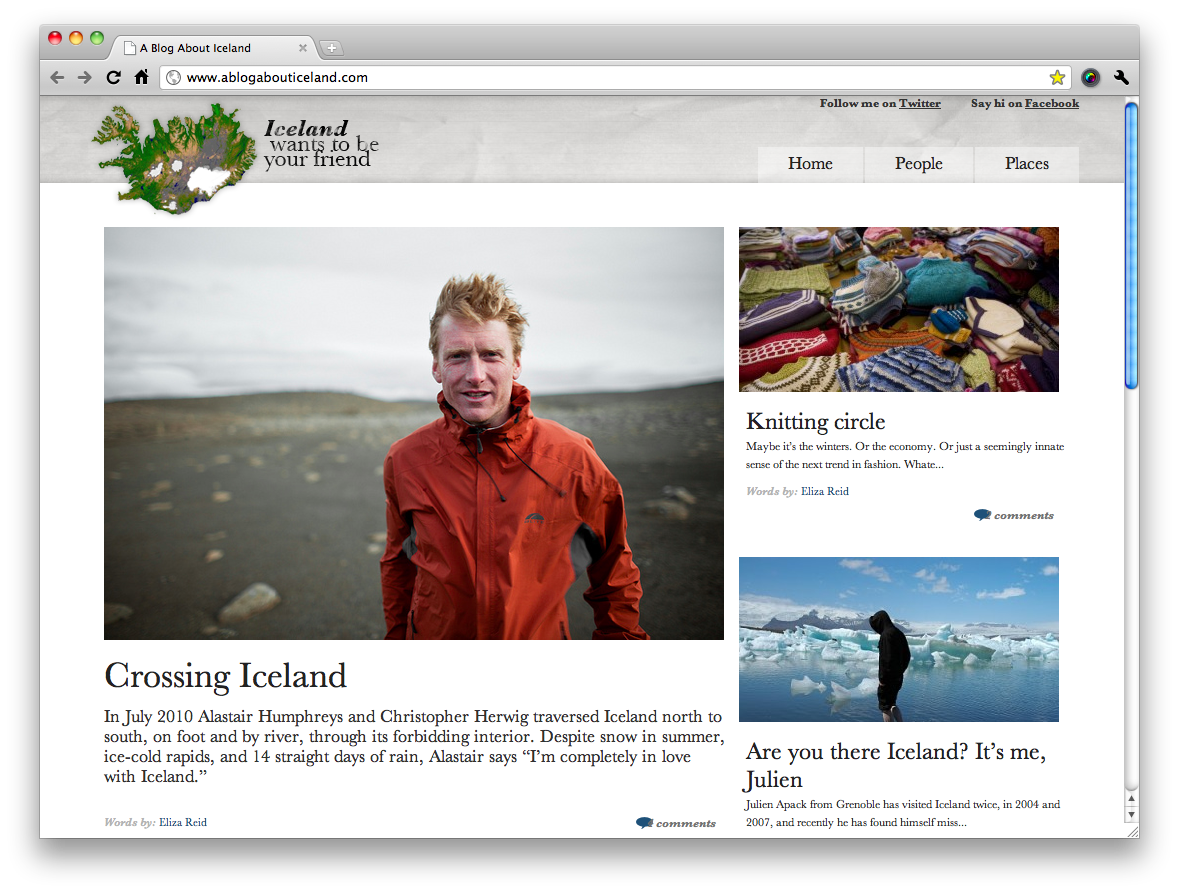
The blog is a place where people talk, as opposed to Iceland — it's the only part of the project where "Iceland" is not speaking in the first person.
By focusing on actual people the blog gives a depth to the project by allowing us to talk about things "Iceland" would be unable to do in its first-person voice.
The blog also provides good content for the project's other channels, Facebook, Twitter, Tumblr, and the newsletter.
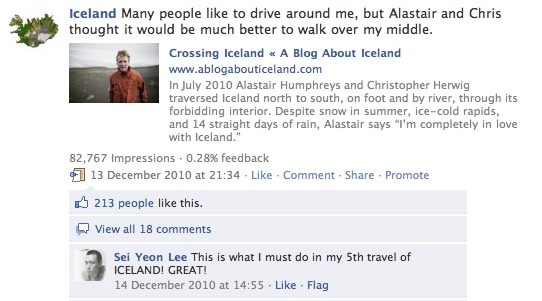
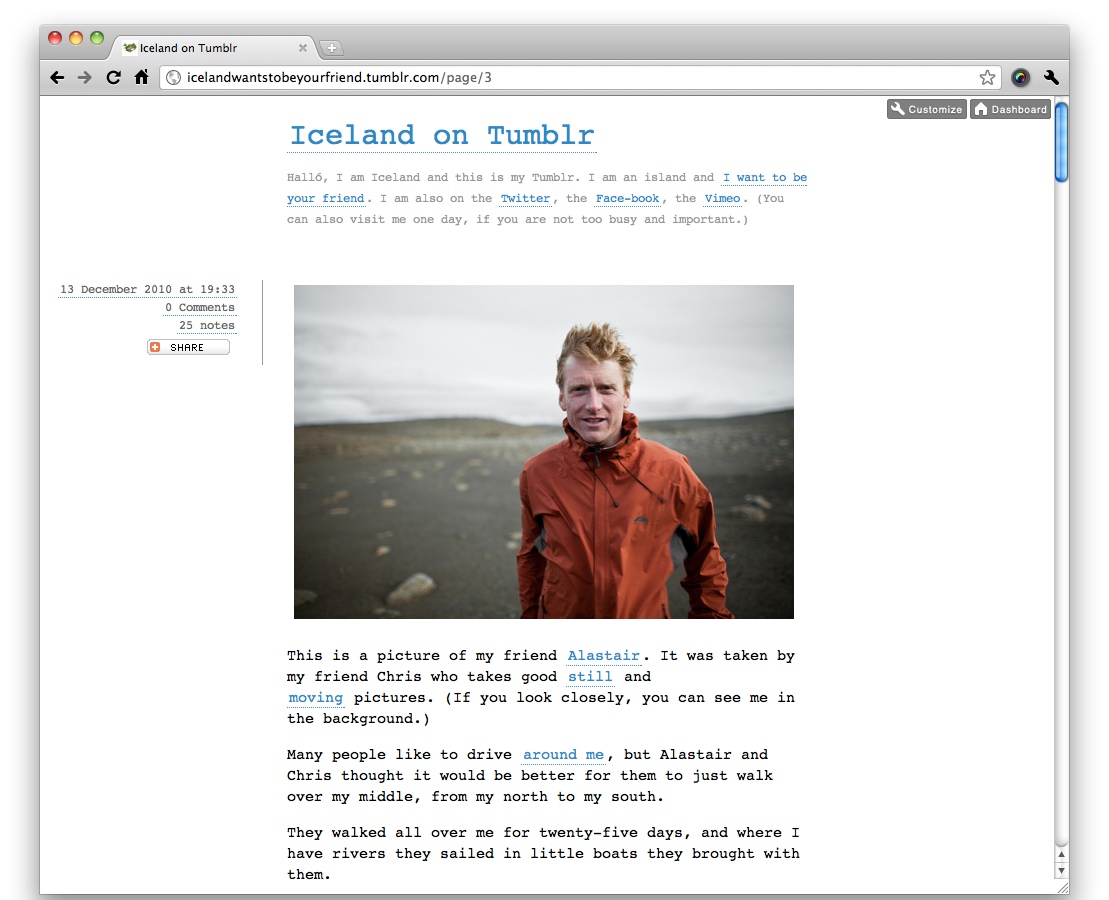
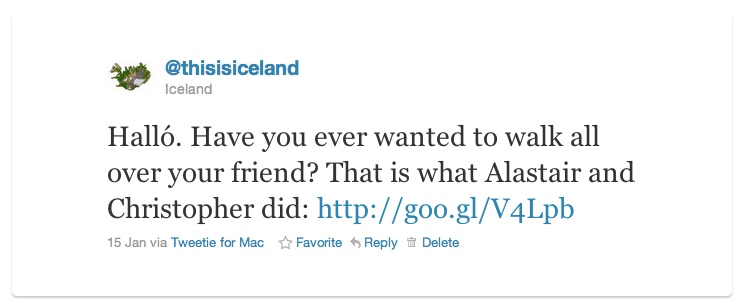
Iceland on Tumblr
In June 2010, Iceland joined the cool kids and started Iceland on Tumblr.
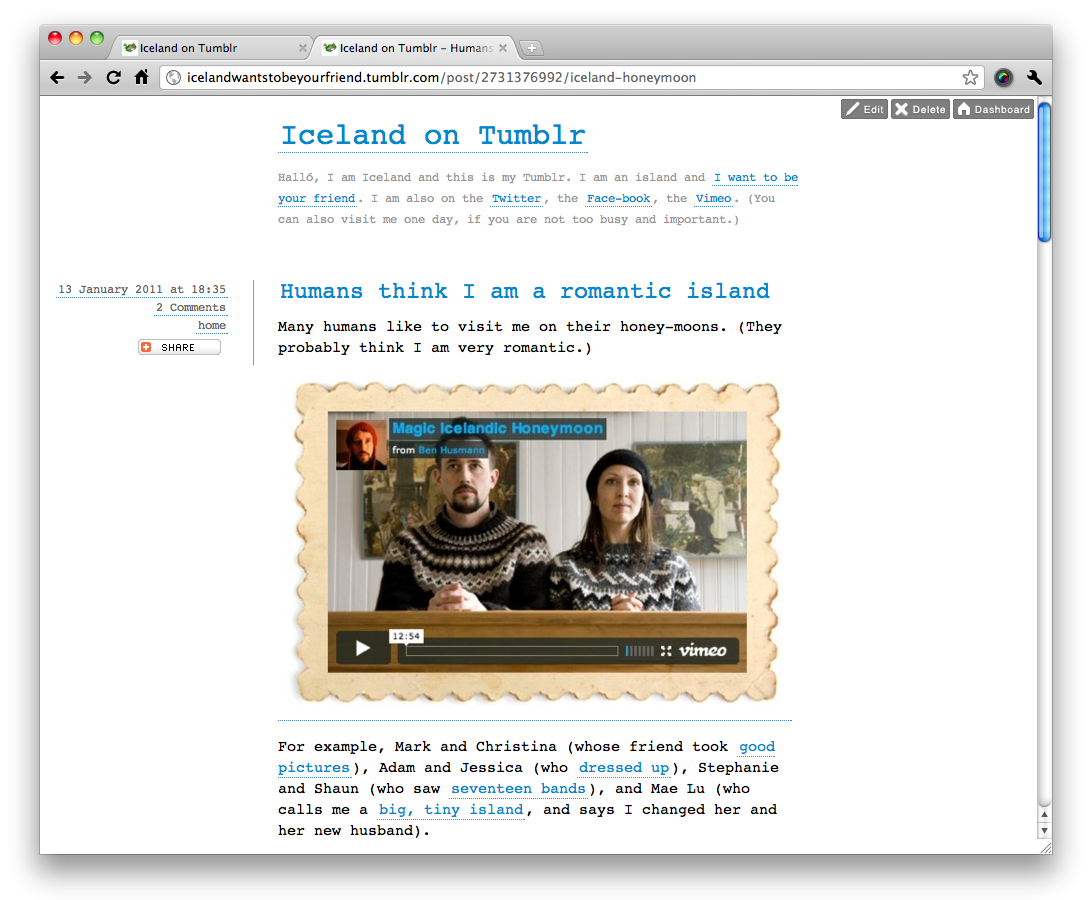
Partly this came as a natural extension of the project — Iceland's first-person voice simply seemed to belong perfectly on Tumblr.
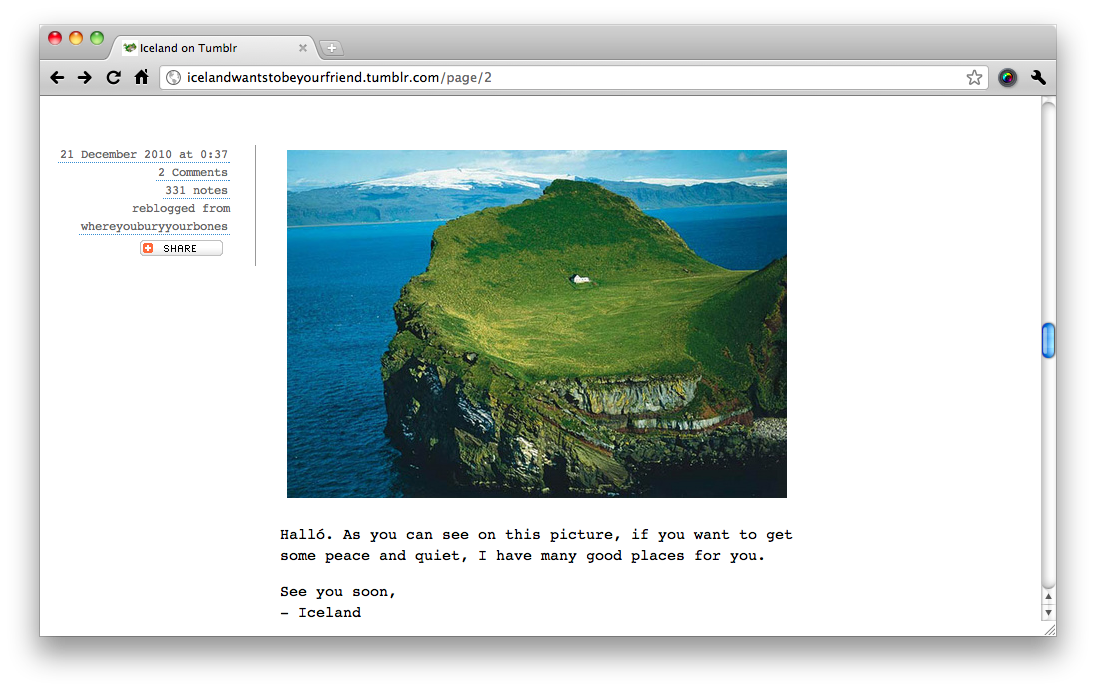
The platform offers both more flexibility than Twitter and Facebook in terms of content, and new ways for Tumblr users to find and share that content with each other. (It did not hurt that around the time Iceland joined it, Tumblr started growing very fast.)
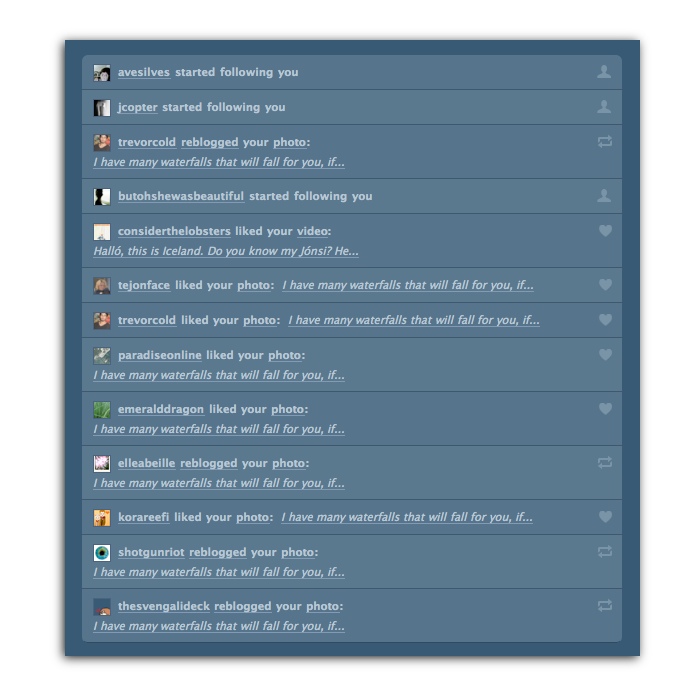
With Tumblr, Iceland also reaches a pretty different group of people than it does on its other channels. Tumblr users are often younger and more used to expressing themselves through social media. Where Facebook has been a great way to find people who were already interested in Iceland, Tumblr has turned out to be a great place to find people and make them interested in Iceland.
Iceland on Vimeo
Videos are an important part of a project for a client as photogenic as Iceland. So of course it set up a profile on Vimeo.
Iceland's activity on Vimeo is twofold. One one hand it curates a growing selection of "Videos with me, Iceland, in them" and "Good music by nice Icelandic people".
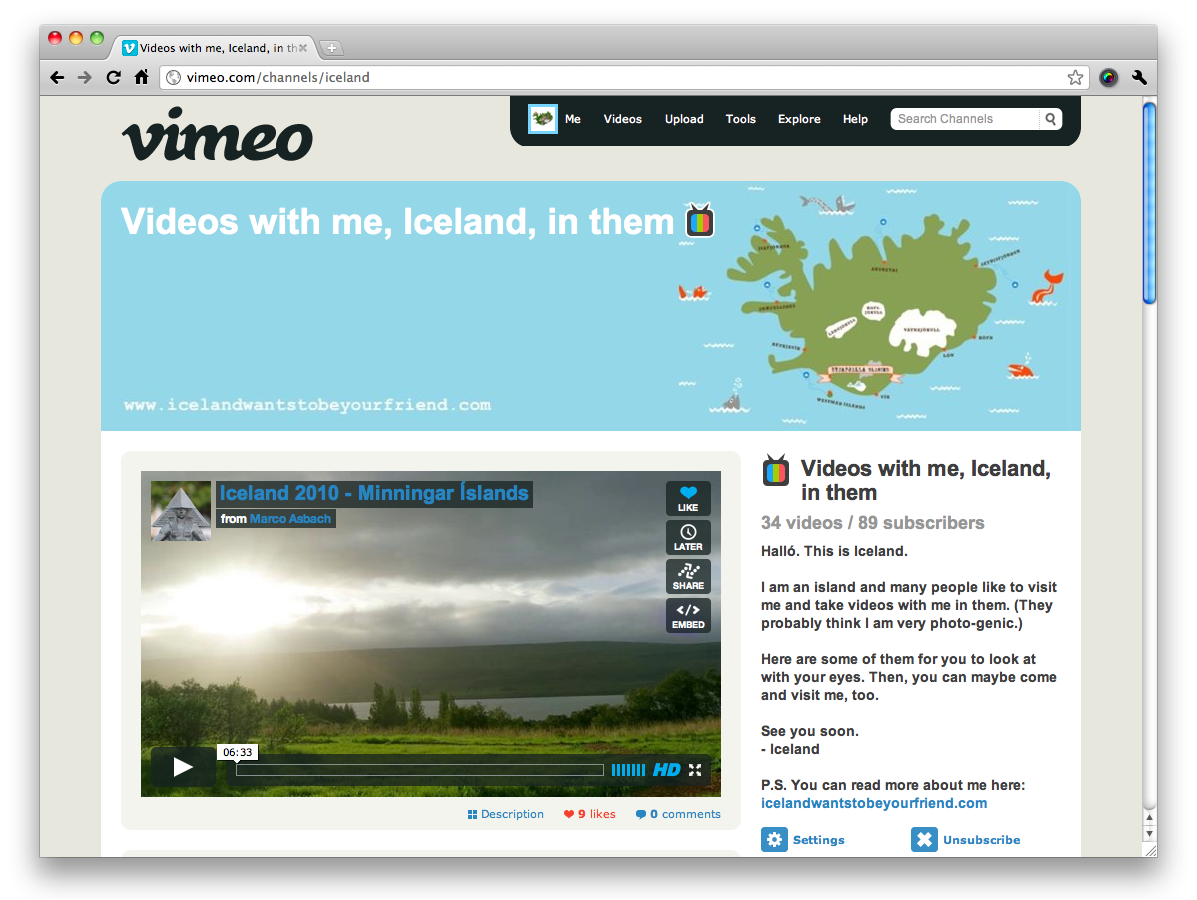
The number of brilliant, high-quality videos made by the incredibly talented people visiting Iceland and posted online is astounding — and needless to say, would cost the Icelandic Tourist Board an enormous amount of money to produce. So instead of trying to top the good things we come across, we simply gather them in one place for more people to see, frequently posting them to the project's other channels. In this way, Iceland Wants to Be Your Friend has become a kind of platform for great "user-generated content".
On the other hand Iceland posts its own videos on Vimeo, produced by the people who "help it with its Inter-nets".
In marked contrast with the user-created videos Iceland curates, these are not fancy and full of colourful images of Icelandic nature. Instead they are very low-key, lo-fi productions, specifically designed to not feel like advertising — especially not like typical tourist advertising.
In addition to traditional food, subjects have included sea-swimming, manly knitting, choir singing and a list of only moderately touristic things to do in Reykjavík. The subjects may be different, but the videos all have in common a kind of subversion of the idea of tourism advertising.
Finally, when that unpronounceable volcano erupted, and many people were wondering if Iceland was covered in ash, we quickly made a special series of clips, showing regular people stranded in Iceland, like this nice man from Manchester.
Iceland on Flickr
Iceland has a profile on Flickr — it's listed as being "single and very, very old" — where it keeps pictures, not of itself, but of the people and places written about on the blog.
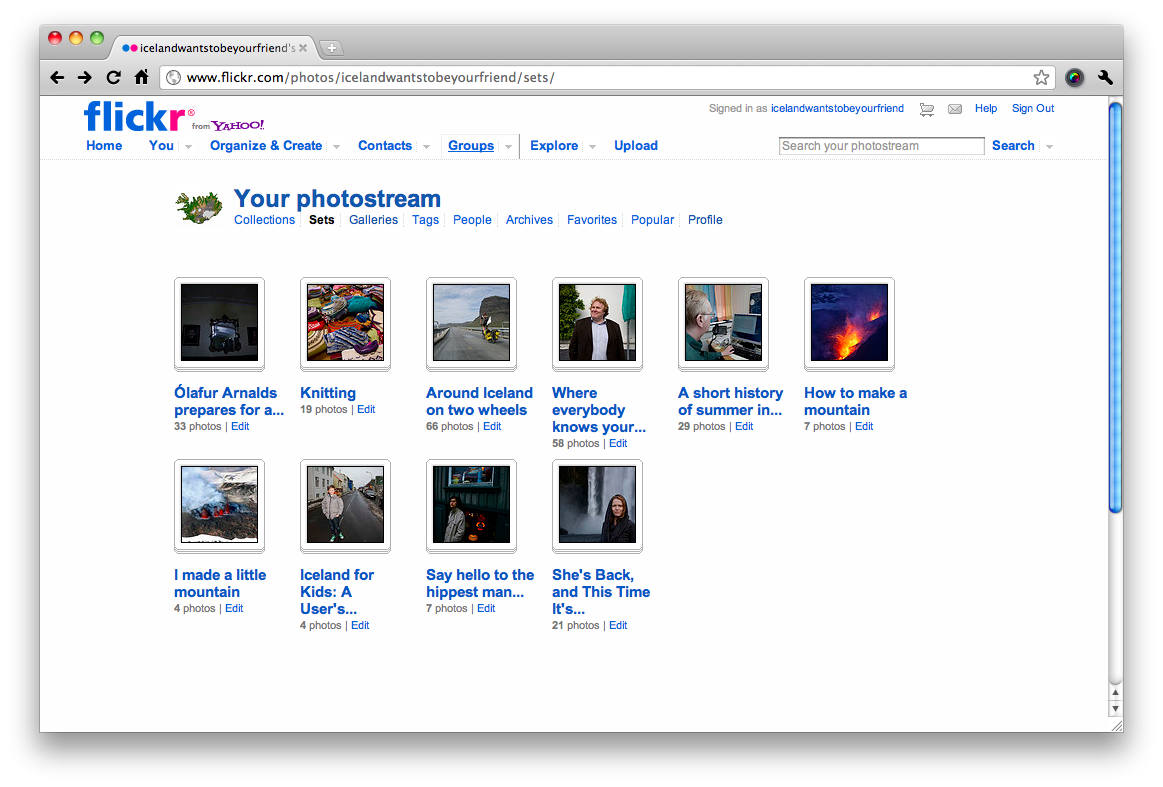
Iceland on Foursquare
The most recent addition to Iceland's suite of social media sites is Foursquare.
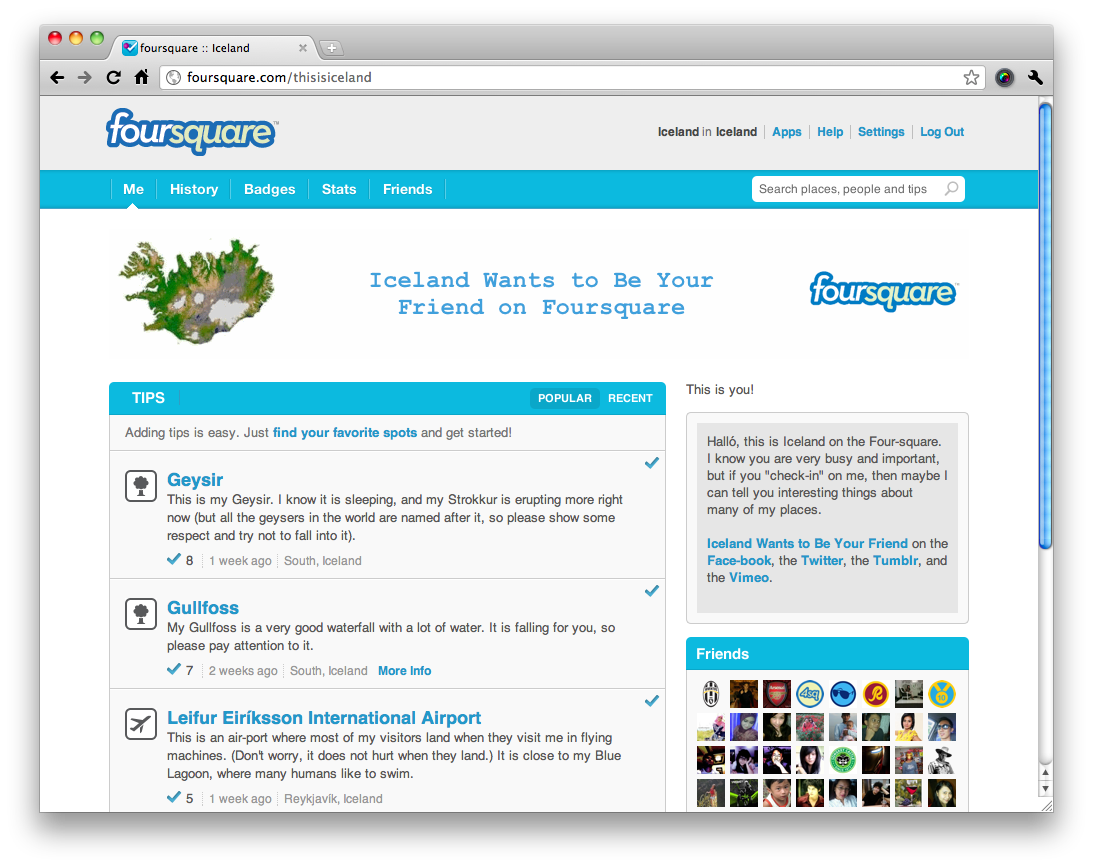
Iceland, of course, "stays put in the middle of the ocean" and does not check-in to any places itself. But with some help from the team at Foursquare it set up a page for itself, has started putting some of its places on Foursquare, and offering friendly "tips" to visitors.
Here below, for example, is Iceland's Foursquare tip about one of its waterfalls, including a reference and a link to a post about the same waterfall on Iceland's Tumblr.
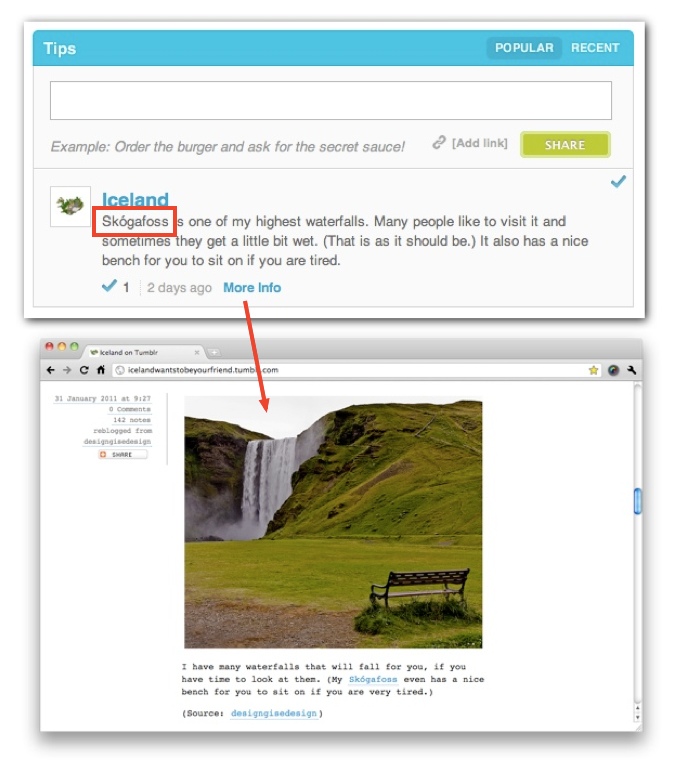
To be quite honest, we're not really sure where Iceland's engagement with Foursquare will lead. But then again we didn't really know where its engagement with any of its other social media channels would lead when the project started.
Emails from Iceland
The last component of Iceland Wants to Be Your Friend we'll talk about here is its email newsletter, sent to about ten thousand good people in many countries all over the world.

To date, Iceland has sent six email newsletters. In March, May, August, September, November of 2010 and in January 2011. These emails serve several purposes, the most important of which is probably to keep users engaged, draw them back in and direct them to content on the project's other channels.
The things people say
"Iceland wants to be your friend is an object lesson in how to do social media well. I love this campaign and the more I look at the detail, care and craftmanship that has gone into it, the better I think it is.
"[Iceland Wants to Be Your Friend's] remarkably well coordinated and designed suite of social media tools is an invitation to travelers, business folk and marketers alike. It’s also a lesson in the aesthetic value of consistency, simplicity and friendliness … Any business, large or small, could follow the logic behind Iceland’s approach with profit … Will it attract visitors and business? It’s certainly convinced me to book a flight for my next holiday."
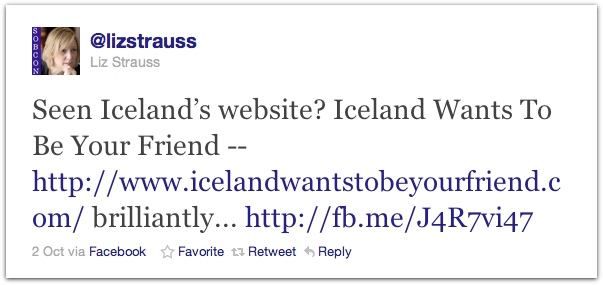
“Whoever’s creating this is super hip. This is what bosses want when they say they want to leverage Facebook, Twitter and the Web. What I don’t think they get is how hard it is to actually be effective with it.”
"An intelligent and focused strategy of Tourism 2.0 … A veritable compendium of best practices of CSM (Customer Social Management) … positions Iceland as a rather upscale destination … The refinement is pushed to extremes … With all of this, would you not want to go on holiday in Iceland? I would."

“Simple, straightforward, but extremely effective — inspiring near-fanatical outpourings from Iceland enthusiasts near and far.”
"Iceland is exemplary in terms of the simplicity and finesse of its approach … Impeccable execution … A country that has understood that on the Internet, the relational dimension is an indispensable prerequisite."

"Intriguing … Engaging and remarkable … Incredibly well done … The Iceland marketing effort takes things to a whole new level … Consider me sold."
"I must confess that I know next to nothing about Iceland — I certainly never thought of it as an example of best practice social media campaigning — but after stumbling across this amazing campaign, I’m almost convinced that I should buy a plane ticket … It is a great case study of how to run a consistent theme, message and identity across multiple platforms — where they can all build upon each other, rather than be diluted … Consistency, a range of social media channels, and an authentic voice are all reasons that this campaign stands out for me."
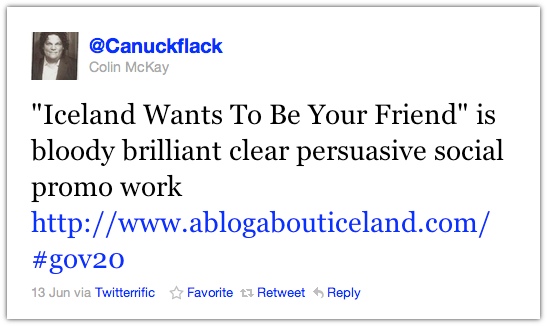
"Go here right now: icelandwantstobeyourfriend.com. This marketing campaign is absolutely hilarious, genius, and refreshing. I want to be Iceland’s friend, a lot, after reading through all this (go to the Twitter or Facebook page for more fun)."
"Speaks to active, young Internet users for whom social media represents the main communication environment. The laid-back language encourages dialogue … which also means huge savings in advertising. … The rebirth of Iceland as a brand that will attract mainly young tourists … We can only hope that [the Slovenian] Tourism Association can learn something from this."
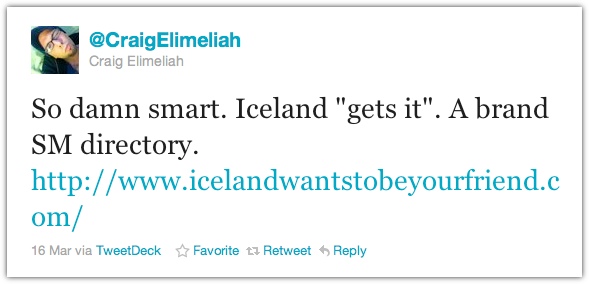
"Compare [the Italian] tourism portal with what the Icelanders are doing, and tell me which is the coolest of the two countries."
“It will make you smile and feel a happy, warm Icelandic glow inside.”
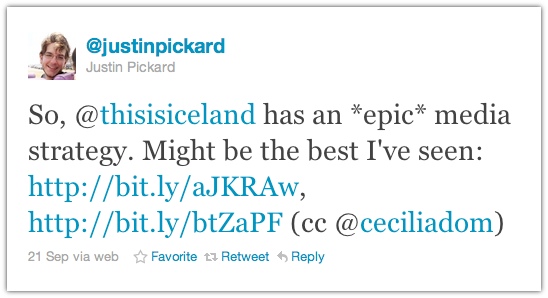
Want to read more of the things people have said about the project?
The slideshow
We made a little presentation for Social Media Week in Iceland. Here it is:
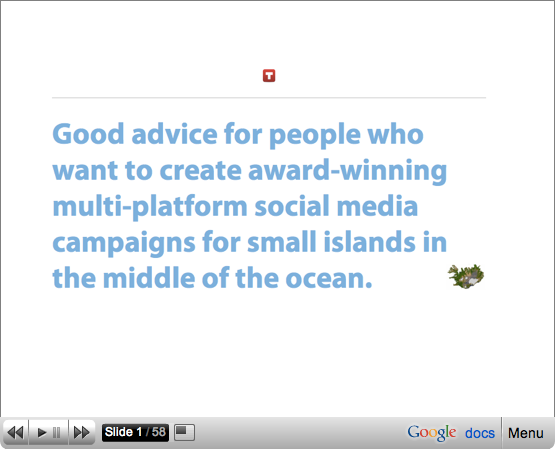
More to come …
As you can imagine there are lots of interesting things to talk about, for example
- where all of this is leading to (as if anyone knows)
- why Iceland Wants to Be Your Friend is possible where Germany Wants to Be Your Friend might not be
- does it actually make people visit Iceland in a flying machine?
- why Iceland doesn't talk to people like advertising talks to people
- why we think the people at the Icelandic Tourist Board and Promote Iceland are so clever
- why Iceland hasn't advertised very much (but also, where it did advertise, and why)
- how Iceland has helped its friends to give each other good advice
- how Iceland dealt with the Eyjafjallajökull eruption
- the difference between Iceland Wants to Be Your Friend and Inspired by Iceland
- what Iceland said about "an old Spice-Man"
- what one person called "the best response to a Facebook spam post ever"
You can wait for all that — just follow @takktakk on Twitter for updates. Or, you can just come and visit Iceland in a flying machine.
Want to tell people about this article?
Why, what would be ever so lovely.
Too much? Not enough?
Questions or comments? Anything you want to know? Anything we've missed? Just email us at hello@takktakk.com or tweet us at @takktakk and we'll do our best to answer.
